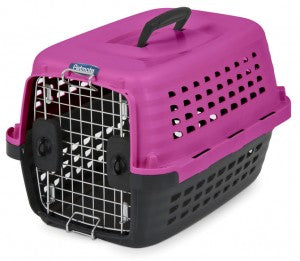Fostering a Feral Cat Safely
By Susan Richmond, Neighborhood Cats 
Fostering a feral cat safely means not letting him or her go in your bathroom and hoping somehow you'll get him in a carrier later. Or releasing him into your bedroom then trying to figure out how you'll ever get him out from under your bed.
Remember that your environment is totally unfamiliar to a feral cat and you are perceived as a threat, especially in this strange new territory. You have to give the cat a space where he feels safe and where he can either learn about his new surroundings, if he's interested in doing so, or quietly retreat.
That's what the Feral Cat Setup allows you to do. In the rare cases where someone has a good reason for trying to adopt a feral cat, the chances of a successful transition to indoor life are greatly increased by use of the Setup for at least two or three weeks until the cat is visually comfortable. At that time, the cage door can be left open for the cat to come and go as he pleases.
The Setup can be done using either a Feral Cat Den or a small carrier. We recommend using a den because it is safer and easier. However, we realize many people will only have access to a small carrier due to time constraints or costs. 
1. Materials needed:
- Cage, at least 36" x 24" x 20"
- Small cat carrier with swinging and lockable front door
- Small litter pan (the smallest - can use aluminum baking pan)
- Yardstick or broomstick
- Cotton sheet
- Newspaper
- Food and water dishes
- Twist tie
- Small towel (optional)
2. The setup (without the cat):
Heavy Weight Stainless Steel Bowls
The bottom of the cage is lined with newspaper. The carrier sits in one of the rear corners - whether left or right depends on which direction the front door opens. When fully open, the door needs to rest against the side of the cage, not being swinging in the middle. Side by side to the carrier is the litter box. Food and water dishes are placed towards the front of the cage. A sheet covers the back half of the cage, but needs to be large enough to cover all of it when necessary to calm the cat.
Havahart® Live Animal Cage Trap
3. Putting the cat inside:
The cat should already be inside the carrier when placing him into the setup. Do not try to release the cat directly from a trap into the cage -- he will be able to easily escape otherwise. Ask your veterinarian to place the cat into the carrier following spay/neuter surgery. With the cat in the carrier already, follow these steps:
- a) Place the carrier with the cat into the rear corner of the cage.
- b) Slide the yardstick or broom handle through both sides of the cage so it bars the carrier door from opening.
- c) Unlock the carrier door, leaving the yardstick in place. Use a plate or book to shield your hand if you're concerned about getting scratched.
- d) Place food and water at the front of the cage.
- e) Close and lock the cage door.
- f) Remove the yardstick, then use it to reach into the cage through the bars and maneuver the carrier door open until the front door rests against the side of the cage.
- g) Use the twist tie to secure the carrier door to the side of the cage.
- h) Cover the cage partially or fully with the sheet to calm the cat.
4. Feeding and cleaning
: 
In order to safely open the cage door to feed and clean, the cat must be inside the carrier with the front door locked. Usually, a feral cat will run into the carrier as soon as you approach the cage.
If he doesn't, you may need to coax him inside by making a loud noise, tapping the side of the cage, poking gently with the yardstick or spraying a small amount of water towards him.
Once the cat is inside the carrier, follow these steps:
- a) Untie the carrier door from the side of the cage.
- b) Using the yardstick, maneuver the carrier door shut.
- c) Bar the carrier door by sliding the yardstick through the sides of the cage just in front of the carrier door.
- d) Open the cage door.
- e) Lock the carrier door.
- f) Clean up and leave food in front.
- g) Unlock the carrier door, using a plate or book to avoid scratches. Leave the yardstick in place, barring the carrier door from opening.
- h) Close and lock the cage door.
- i) Remove the yardstick.
- j) Use the yardstick to open the carrier door.
- k) Twist-tie the carrier door to the the side of the cage.
- l) Cover the cage partially or fully with the sheet.
~ ~ ~ ~ ~ ~ ~ ~ ~ ~
Excerpted with permission from Neighborhood Cats
Susan Richmond is the Executive Director of Neighborhood Cats, and has devoted her career to helping animals. Neighborhood Cats believes Trap-Neuter-Return (TNR) is the most humane and effective method available to end the severe feral cat overpopulation crisis faced by this country. Their mission is to make TNR fully understood, accepted and practiced in every community.


